"On Sunday, January 9th, 1905, Tsar Nicholas II ordered troops to fire on a peaceful procession of workers demonstrating in St. Petersburg, unleashing a storm of strikes, mutinies, violent uprisings, and brutal reprisals that raged across Russia for well over a year.
Known collectively as the Revolution of 1905, these upheavals transformed the political landscape and set the stage for the Russian Revolution of 1917 and the Civil War that followed. Bloody Sunday also marked an important watershed for Russian graphic artists. With the momentary collapse of censorship, over 300 different satirical magazines were published during the Revolution of 1905, more than had seen the light of day in Russia during the entire nineteenth century. Most of them survived for only a few numbers before the censors caught up. Yet the output was impressive all the same.
Rushing to fill the expressive void, artists and writers captured the events and personalities of the revolution with biting satire and aesthetic sophistication. While styles and subject matter varied, artists often chose to depict nightmarish scenes of bloodshed and repression, drawing on images of the macabre and the mystical that had already been in vogue in Symbolist circles across Europe at the turn of the century." [source]
“For a few brief months the journals spoke with a great and unprecedented rage that neither arrest nor exile could silence. At first their approach was oblique, their allusions veiled, and they often fell victim to the censor’s pencil. But people had suffered censorship for too long.Satirists constantly expanded their territory and their targets of attack, demolishing one obstacle after another as they went, thriving on censorship.
The workers’ movement grew in boldness, culminating in the birth of the St Petersburg Soviet of Workers’ Deputies, the people’s government. For fifty days the Tsar and his ministers were confronted by another power, another law. Journalists and printers seized the right to publish without submitting to the censor. The satirical journals then reached their apotheosis, until the revolution died as it had risen, bathed in blood.”
From the introduction to 'Blood and Laughter: Caricatures from the 1905 Revolution', 1983 by C Porter & D King [Thanks JM!]
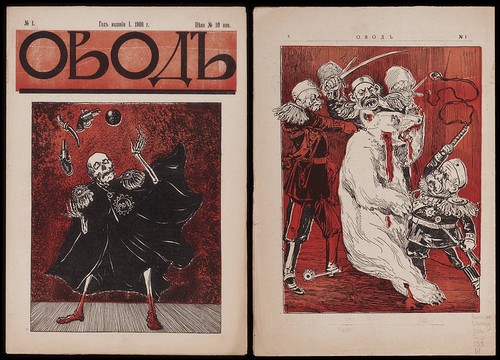
Author: Gints, G. E.
Golmstrem, A. A. Iurevich, V. N.
Karpov, G. P. Kirsanov, K.
Kniazev, Vasilii Vasilevich, 1887-1937?
Lebedev, V. P. (Vladimir Petrovich), 1869-1939.
Morozov, P. Ongirskii, V. M.
Rysis, A. D. Shcheglov, A. A.
Varezhnikov, A. V. Vasilevskii, I.
'Ovod'
Saint Petersburg, 1906
8 p. ill. 35 cm.
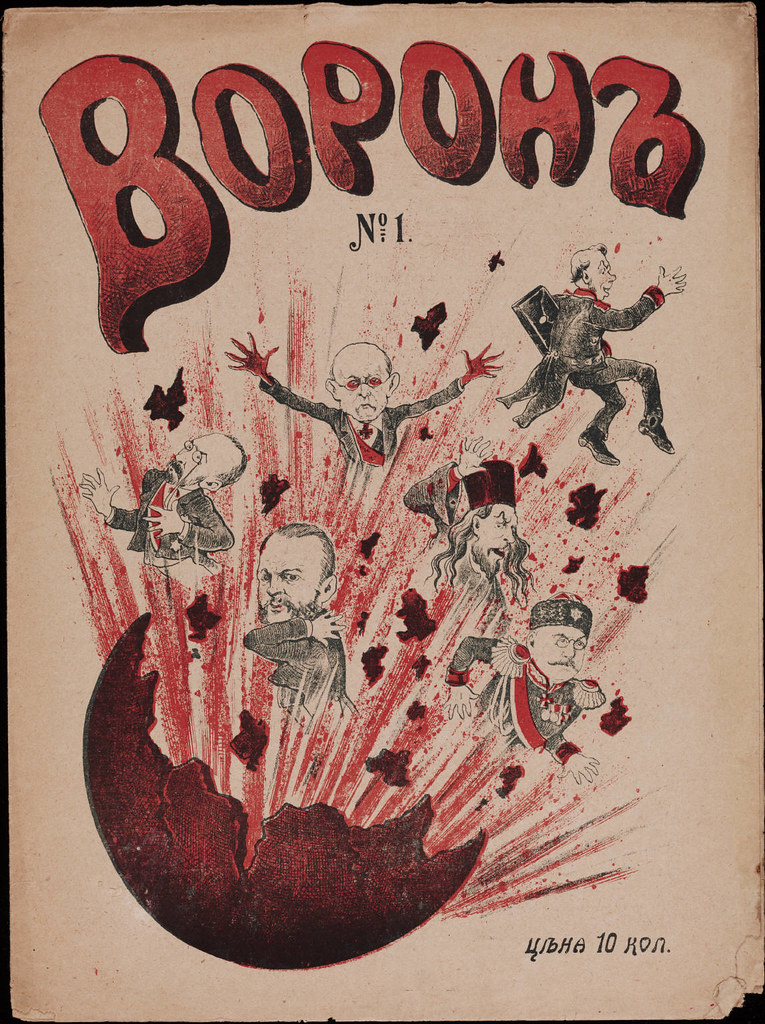
Author N. Vasin
'Voron'
Saint Petersburg, 1906
8 p. col. ill. 36 cm.
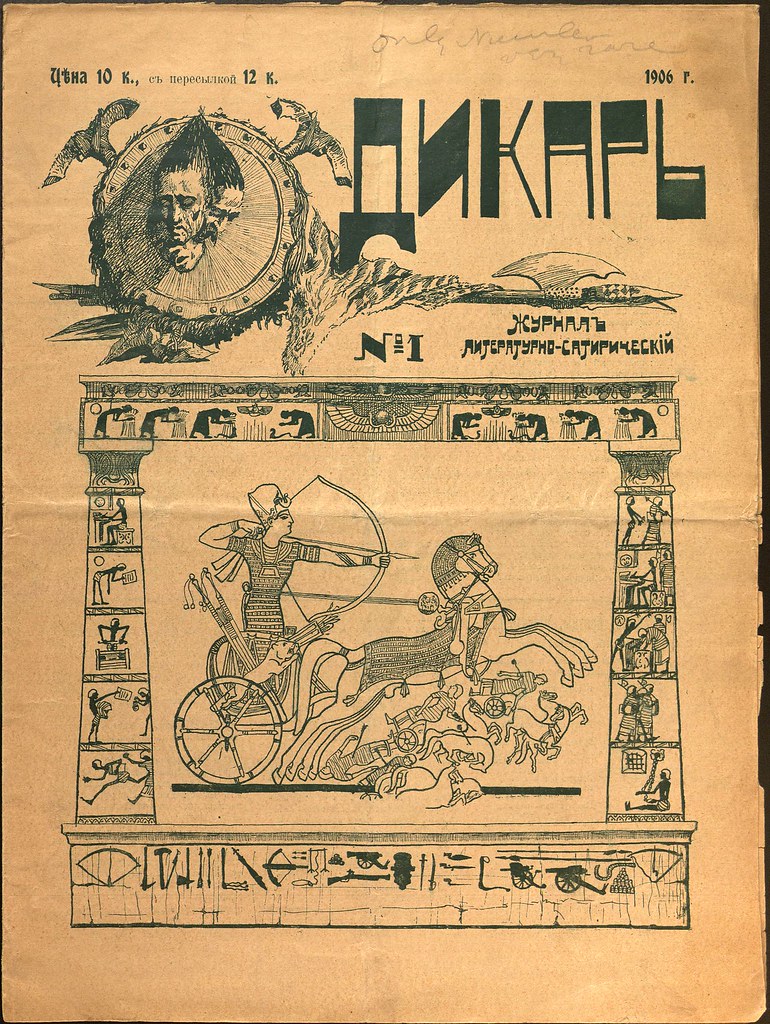
Sinitsyn, Ya. D., Editor
'Dikar'
Sankt-Peterburg: Sinitsyn, Ya. D., 1906
1 v. : 8 p. ill. ; 35 cm.
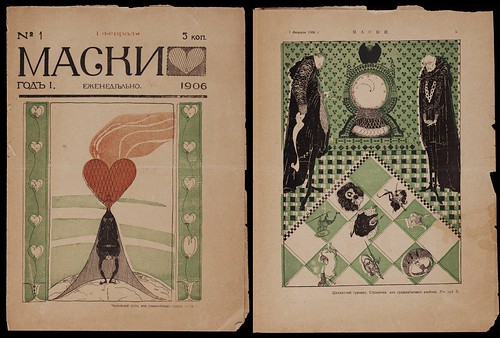
Author
Chekonin, S. V. Chernyi, Sasha.
Deters, E. V. Geier, B. F.
Gerardov, N. N. Godin, IA. V.
Kaizerman, G. IA.
Krandievskaia-Tolstaia, N. (Natalia), 1888-1963.
Kartsov, V. S. Kudinov, A. A.
Likhachev, V. S. (Vladimir Sergieevich), 1849-1910.
Mikhailov, V. G.
'Maski'
Saint Petersburg, 1906
8 p.
col. ill.
32 cm.

Sinitsyn, Ya. D., Editor
'Dikar'
Sankt-Peterburg: Sinitsyn, Ya. D., 1906
1 v. : 8 p. ill. ; 35 cm.
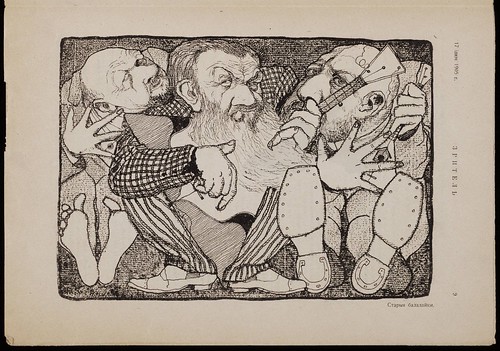
Author
A. K. (Aleksandr Kondratev), b. 1876.
Artsybushev, IU. K. (IUrii Konstantinovich), 1877-1952.
Bariatinskii, V. V. (Vladimir Vladimirovich), kniaz, b. 1874.
Bashkin, V. V. Biatkin, G. A.
Chapygin, Aleksei, 1870-1937.
Chekhonin, Sergei Vasilevich, 1878-1936
'Zritel'
16 p. col. ill. 33 cm.

Vakhrameyev, A. I.; Zlatovratskiy; A. N.; Zasodimskiy; P. V.; Bezpalov, I. F., Editor
'Gamayun'
Sankt-Peterburg: Zlatovratskiy; A. N., 1906
1 v. : 10 p. ; ill. ; 33 cm.
[alternative version - unripped]
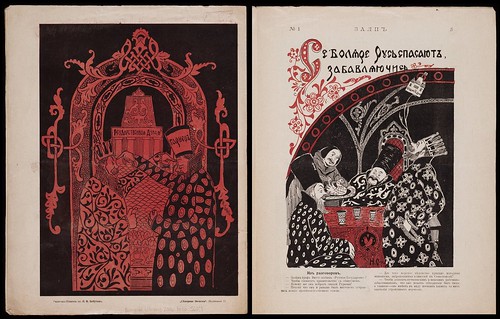
Author: Bebutov, P. V.
Lazarev-Gruzinskii, A. S.
Roslavlev, Aleksandr, 1883-1920.
Seven, N. N. Svobodin, M. P.
'Zalp'
Saint Petersburg, 1905
8 p. ill. 36 cm.
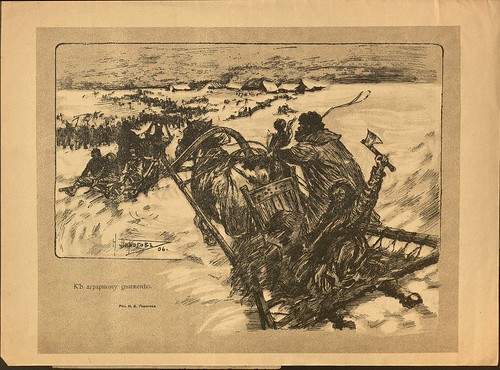
Vakhrameyev, A. I.; Zlatovratskiy; A. N.; Zasodimskiy; P. V.; Bezpalov, I. F., Editor
'Gamayun'
Sankt-Peterburg: Zlatovratskiy; A. N., 1906
1 v. : 10 p. ; ill. ; 33 cm.
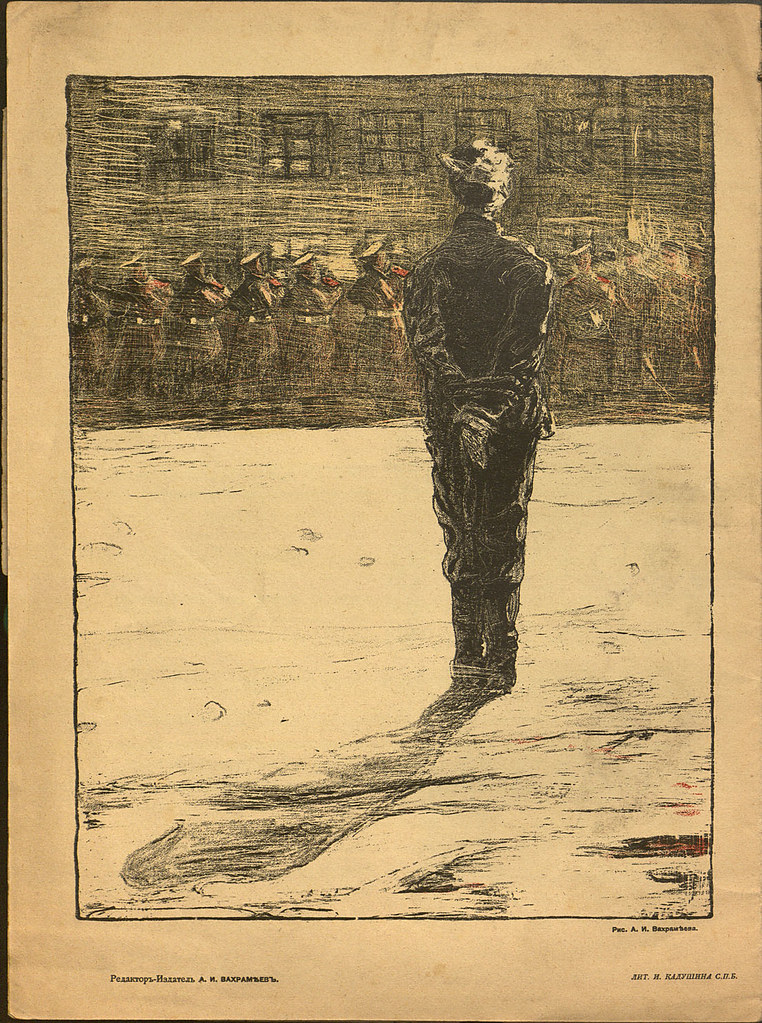
Vakhrameyev, A. I.; Zlatovratskiy; A. N.; Zasodimskiy; P. V.; Bezpalov, I. F., Editor
'Gamayun'
Sankt-Peterburg: Zlatovratskiy; A. N., 1906
1 v. : 10 p. ; ill. ; 33 cm.
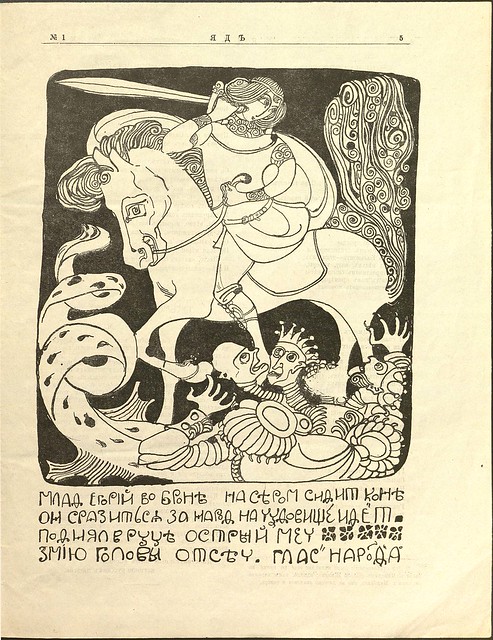
Petrov, A. M., Editor
'Yad'
Sankt-Peterburg: Petrov, A. M., 1905
1 v. : 8 p. ; ill. ; 23 cm.
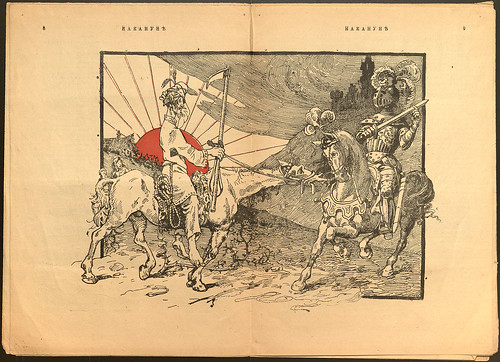
Gol'dberg, Yu. V., Editor
'Nakanune'
Sankt-Peterburg: Gol'dberg, Yu. V., [1907]
1 v. : 16 p. ; ill. ; 32 cm.
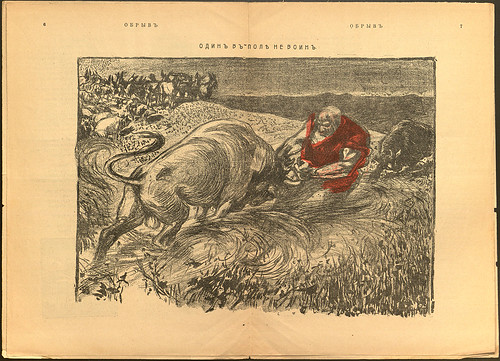
Gol'dberg, Yu. V., Editor
'Obryv'
Sankt-Peterburg: Gol'dberg, Yu. V., 1907
1 v. : 12 p. ; ill. ; 32 cm
The print title is 'Odin v pole ne voin' {Один в поле не воин}: "One man in the field is not a warrior" or "One man alone can't win a war" --- this was the Russian title of German book by Friedrich von Spielhagen (d. 1911) that featured the revolutionary character Leo and was wildly popular in Russia.
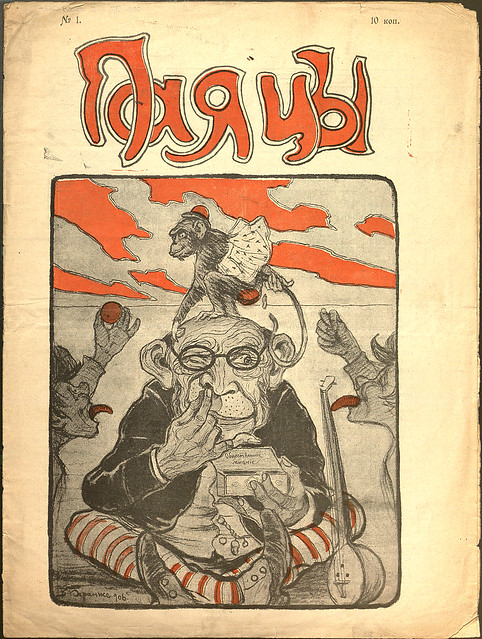
Vyshomirskiy, V. M., Editor
'Payatsy'
Sankt-Peterburg: Vyshomirskiy, V. M., 1906
1 v. : 8 p. ; ill. ; 46 cm.
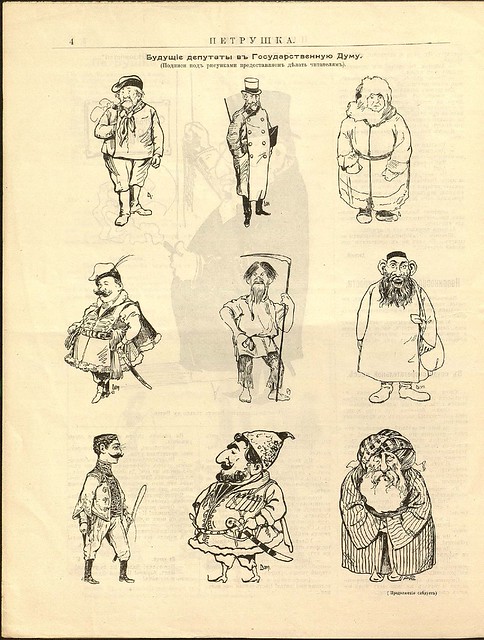
Adamov, E. M. (Kholodnyy), Editor
'Petrushka'
Sankt-Peterburg: Adamov, E. M. (Kholodnyy), 1905
1 v. : ill. ; 33 cm.
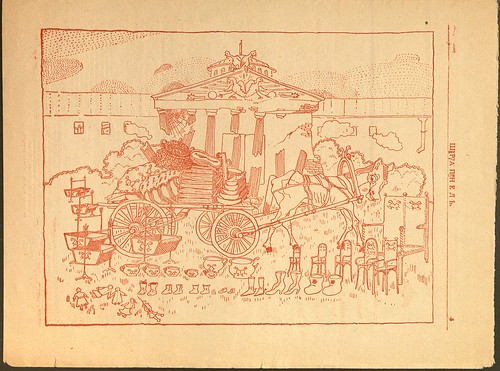
Milyayev, V. E., Editor
'Shrapnel' 1
Moskva: Milyayev, V. E., 1905
1 v. : 8 p. ; ill. ; 30 cm.
Illustration of royal family's belongings in front of ruined palace
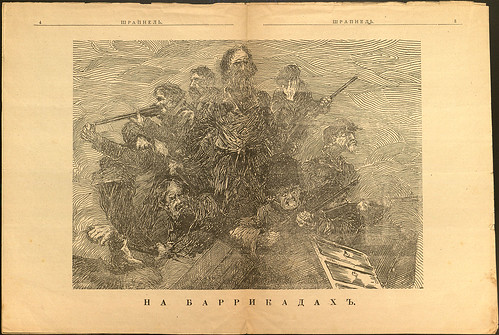
Milyayev, V. E., Editor
'Shrapnel' 2
Moskva: Milyayev, V. E., 1905
1 v. : 8 p. ; ill. ; 30 cm.
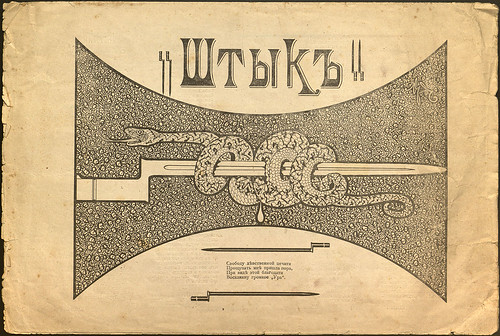
[Kisnemskiy, S. P.], Editor
'Shtyk'
Sankt-Peterburg: [Kisnemskiy, S. P.], [1906]
1 v. : 8 p. ; ill. ; 41 cm.
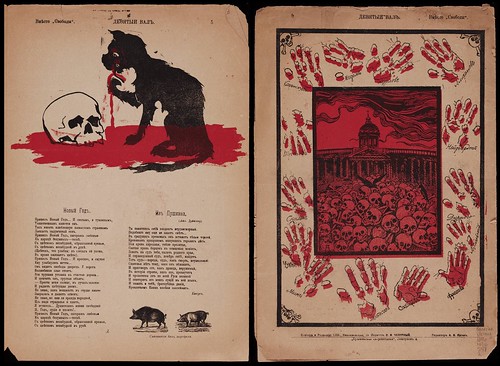
Author: Chepurnyi, S. I.
Chisliev, D. G. Dymow, Ossip, 1878-1959.
Iargin, A. I. Panov, N. A. (Nikolai Aleksandrovich), b. 1848.
Rudenko, S. I. Usas, S. M.
Publisher: S.I. Chepurnyi,
Saint Petersburg
'Deviatyi val.' 2
8 p. ill. 35 cm.
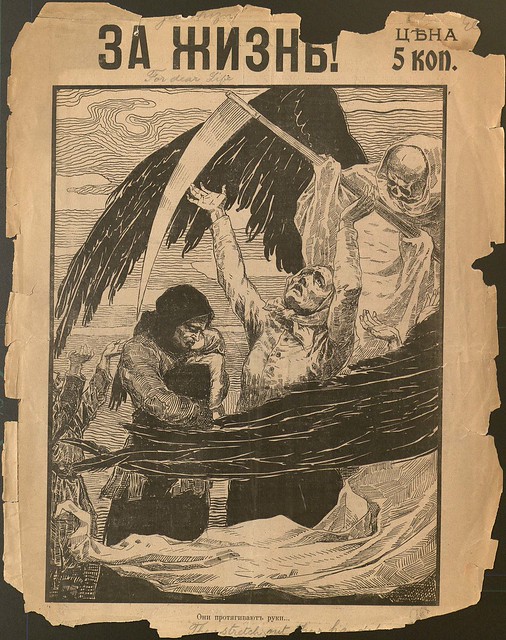
[Prokhorov, S. M.], Editor
'Za zhizn'!'
Sankt-Peterburg: [Prokhorov, S. M.], 1905
1 v. : ill. ; 35 cm.
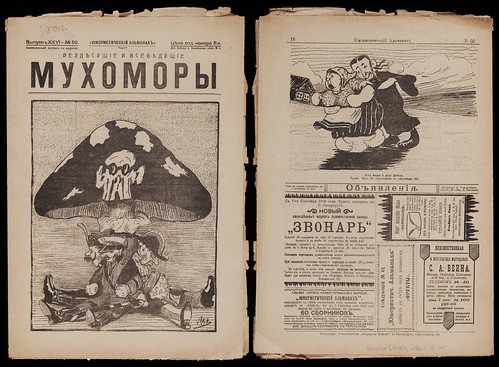
Author: Assaturov, P. K.
Evstafev, P. M. Iazenko, N. I.
Ivanov, D. I. (Dmitrii Ivanovich), 1891-
Kartsov, V. S. Kaufman, M. S.
Kniazev, Vasilii, 1887-1937?
Krasnitskii, A. I. (Aleksandr Ivanovich), b. 1866.
Lvovich, M. Mikhailov, K. A. (Konstantin Arsenevich)
'IUmoristicheskii almanakh'
16 p. ill. 32 cm.
As JMorrison rightly pointed out in his Nonist post from a few years ago, we westerners have to modify our concept of the word 'satire' to accommodate some of the grim subject matter examined in the early 20th century Russian satirical journals.
That's not to say they are devoid of humour, but the process of drawing and publishing some scenes must have been a catharsis itself, without the need for a comic overlay. If life for the general populace was so depressing and bleak at the best of times, it's a hard task for an editorial cartoonist or illustrator to convincingly skewer abominable crimes of the wicked oppressors (or whomever) beyond simply recording their occurrence in an underground publication.
{Edit: Thinking about this later, the opinion above is less applicable to the (biased of course!) selection of images in this entry than it is to the whole corpus of post-revolutionary graphic art journals.]
On a happier note, this post gave me the opportunity to revisit three of my all-time favourite destinations on the interweb, viz:
~~ The University of Wisconsin Digital Collections -- Russian Satirical Journals.
~~ Yale's Beinecke Rare Books & Manuscript Library -- Russian Graphic Art and the Revolution of 1905.
~~ The Nonist -- sadly dormant now, but never forgotten -- Wit Larded with Malice.
See also: The University of Southern California Libraries site: Russian Satirical Journals of the 1905 Revolution.



















7 comments :
Well, I think I had never post a comment here because I supposed that an amazing blog like this one maybe it does not need such thing. But today I thought there is a wonderful mind behind the curtains waiting for the applause. Here you have a lot. And thank you for sharing those amazing images. I am illustrator and this blog is a feast for my eyes. And something lusty. Almost a deadly sin.
Some of these images remind me of an artist by the name of Ben Steele, who recorded his experience as a victim of the Bataan Death March during WWII. I don't know why they strike me so morbidly, but they do speak. Thanks for posting them.
the Prozhektor is at fault in your small list
of 1906 satirical magazines
va fi vizibil după aprobare to accommodate some of the grim subject matter examined in the early 20th century Russian satirical journals?
is common to german satire und some other magazines of the same time with morbid thematika
as humour
over 300 different satirical magazines were published during the Revolution of 1905,
many of this 300 are posterior to the revolution/uprising of 1905
more than had seen the light of day in Russia during the entire nineteenth century??
I'd like to volunteer my perspective of this review as an ex-Soviet immigrant who knows his history -
The text accompanying the artwork sounds as if it were written by a Soviet propagandist. It's exactly the simplistic, black-and-white version of history we were taught in Soviet schools: the impossible economic and intellectual oppression of the pre-revolutionary years, which prenecessitated the revolution. It's as if the revolution was the best thing that happened to Russia and its people.
But the quality, diversity, and the sheer number of these satirical publications contradict this very statement (some of those were purely artistic and literary journals - Gamayun, etc.). Russian culture and economy were actually on the rise when the revolution happened. It is afterwards that the impossible economic and intellectual oppression ensued. None of these publications would have survived the Bolshevik rule, even if they weren't censored - because of the sorry state of the economy. I wonder how many of these satirists were arrested and shot a few years later by their "liberators."
The ugly truth is, the revolution in Russia was facilitated by a whole class of idle "liberal" intellectuals who were ideologically very close to the American progressives. Some of these satirists belonged to that type, and they later fell victim to their misguided idealism. Dostoyevsky predicted that "the liberals will be the death of Russia." We might add that the Russian liberals were later largely exterminated by the Bosheviks, who also rejected Dostoyevsky as a "reactionary right-winger."
History is a treasure trove of useful lessons, if we only open our minds to it.
The images here are shockingly powerful and explicit. And based on the previous comments still able to initiate a debate. As a proud graduate of the University of Wisconsin-Madison, I'm quite pleased that my alma mater collects such revolutionary art.
Post a Comment
Comments are all moderated so don't waste your time spamming: they will never show up.
If you include ANY links that aren't pertinent to the blog post or discussion they will be deleted and a rash will break out in your underwear.
Also: please play the ball and not the person.
Note: only a member of this blog may post a comment.